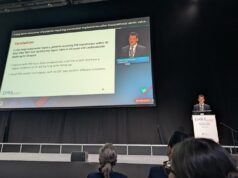
Although much of the innovation in transcatheter solutions for structural heart disease is now focused on mitral and tricuspid approaches, novel devices for transcatheter aortic valve implantation (TAVI) are also being evaluated. One such device is the “revolutionary” 2P-Valve, which interventional cardiologist Gilberto Melnick (CardioVolution, Brazil) says provides a new solution to paravalvular leak and has the potential to reduce vascular complications.
Presenting data for the device at PCR London Valves (18–20 September, London, UK), during an abstract session on new and established devices, Melnick explained that the modular aortic valve prosthesis is implanted in two parts (hence the name). The first part is the stent frame with a “hook system” and is designed to prevent embolisation, and the second part is a skirted nitinol mesh that is covered with polytetrafluoroethylene (PTFE). “This new technique is hybrid of stent implantation and percutaneous closure of septal defects, so we expect a fast learning curve for interventional cardiologists who are used to performing these types of procedures,” he told Cardiovascular News.
According to Melnick, the device has several potential benefits. For example, when the valve is fully assembled, the covered skirt should prevent both paravalvular leak and systolic embolisation of the nitinol mesh. As the 2P-Valve has a reduced delivery system profile and device crossing profile (compared with other devices), he also believes that “we can assume it will reduce vascular complications”. Furthermore, the 2P-Valve may be able to be used in more complex patients with Melnick noting: “With its reduced delivery system calibre, this device could be implanted trough alternative vascular routes such as the brachial artery. Patients with advanced peripheral vascular disease sometimes cannot be considered for TAVI because they do not have appropriate vascular anatomy for the procedure. Therefore, performing TAVI with a brachial artery approach may be a good solution for these patients.”
Initially conceived in 2013, when the first art sketches were made, the 2P-Valve is now patented and has undergone bench testing. The next step, according to Melnick, is to start ex-vivo and animal testing of the device—which he and his colleagues plan to start in the second quarter of 2017. They are now also looking for investors and funding for the valve.
Concluding his presentation at PCR London Valves, he said: “We face a challenging future and need to better understand some of device’s features but we do think it has potential advantages.”

In the same session at PCR London Valves, Pedro Lemos (Heart Institute (InCor), University of Sao Paulo Medical School, Sao Paulo, Brazil) discussed the primary results of the NAUTILUS (NVT transfemoral multicentric aortic valve pivotal study for safety and effectiveness) study. He noted that in the study, 60 high-risk patients underwent TAVI with the Allegra valve (NVT)—“a novel transfemoral, supra-annular, early functional, retrievable system”. At 30 days, peak gradient decreased from 83±23.7mmHg to 15.3±6.1mmHg while effective orifice area increased from 0.7±0.2cm2 to 1.8±0.5. Also, the rate of all-cause mortality was 1.7% as was the rate of major stroke and major vascular complications. However, the rate of new pacemaker implantation was 16.1%.
“The results of this multicentre NAUTILUS study confirms the findings of the previous pilot first-in-man study, demonstrating the optimal performance of the novel Allegra TAVI system for the treatment of severe symptomatic aortic stenosis in high-risk surgical patients,” Lemos stated.
He told Cardiovascular News: “This new valve has a number of interesting features. It permits a very precise implantation because it is early functional during the deployment, which increases the stability of the procedure and allows the operator to deliver the prosthesis in a stepwise way. It has a line with of radiopaque gold marks that shows the limits of the functional part of the valve. This facilitates the procedure. Instead of having to guess or only estimate where the limits of the leaflets are, as occurs with other valves, this new TAVI device provides direct visualisation of the nadir of the valve. Furthermore, because the valve is retrievable, the operator has the chance to retrieve any mal-positioned prosthesis.
Another new device discussed at the session was Edwards Lifesciences’ self-expanding Centera system (all of the Sapien valves are balloon expanding). =Ulrich Schäfer (Department of General and Interventional Cardiology, University Heart Centre, Hamburg, Germany) reported that the valve consisted of bovine pericardium and a nitinol frame and had a contoured shape. He added that he and his colleagues were planning to present data from for the device, now that enrolment for the CE mark trial had been completed, at the 2017 EuroPCR meeting. “I think Centera is going to be a strong competitor in the market and we are all going to be impressed with data,” Schäfer noted.













